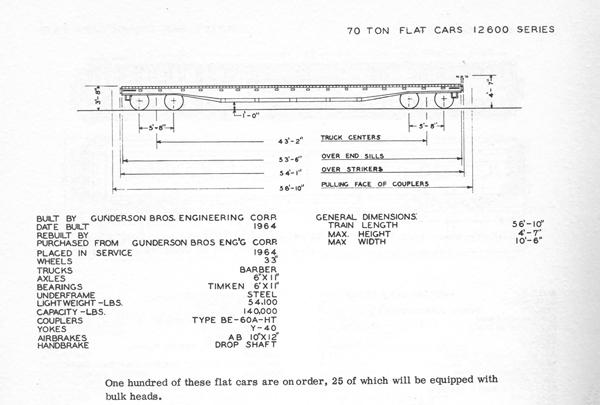
.
One hundred 53' 6" flats were ordered from Gunderson Bros. Engineering
Corp in 1964. Twenty five were to be equipped with bulk heads. They appear on
rosters from 1976 right through 2008. A general layout drawing is found in The
Alaska Railroad by Bernadine Prince on page 1002.
Photos reveal 16 stake pockets which were adapted to a variety of deck loads. Heavy duty log bunks, Extended steel stakes for log bunks and container loads were common. These cars were welded construction and the fish-belly side plates were capped on the bottom edge with a strip of plate steel that ran from end to end. This cap extended about 2 inches beyond the side plate and along with the 16 stake pockets are the major spotting features.
My model #12682 started life as a TICHY Train Group GSC-53'6" Flat Undecorated Part # 1000 which has the required 16 stake pockets and fish belly side frames even though they are of the wrong profile. I made the decision to disregard the General Steel Casting under frame which will not be seen except by me.
To arrive at the right side profile of the fish belly follow these steps:
1. Make up a scale 18" square spacer from styrene, brass and or wood so that it will fit inside the bottom of the deck from end sill to end sill and tight against the side of the car. The top of this spacer should intersect the side of the car at the outside edge of the 5th stake in from the end of the car. Scrape, file or sand the side sill of the car down to the top of the spacer. This should result in a side sill just 21" deep.
2. From the end of the car to the inside edge of the 3rd stake pocket, the bottom of the side should be parallel to the deck and a little filing will make it so.
3. There should be a straight line connecting the inside edge of the 3rd stake pocket and the outside edge of the 5th stake pocket when you are finished with this step. Us blue masking tape to mark the stake pockets at each end and protect them while you file away the offending material between the tape (limits).
Now add the unique cap on the modified fish belly. Glue a strip of .022 X.090 styrene perpendicular to the bottom of the modified side fish belly sheet, placing the strip flush with the side sheet on the inside and extending to the outside. I found MEK or plastic cement applied in small amounts working from the center of the car toward each end worked very well. Once it is all tacked in place you can give it a bead of MEK along the inside to finish the weld.
Remove the small gusset next to the 2nd stake pocket in from each end. And fill the small pocket at that location with a piece of .022 X.090 styrene.
Add tack boards between the 2nd and 3rd stakes on the left end of each side plate. Support panels for the lube placards are made from .010 styrene with a .020 spacer behind them.
Drill the four corners for the 8 ea strait grab irons. (Details Associates 220 work well.) Drill out and install four A-Line #29000 Stirrup Steps Style A at the four corners. Fabricate and install cut levers.
There is a problem with the under frame that will result in your cars couplers setting way too high if assembled to the kit directions. Before assembly cut the truck bolsters and end section of the frame just outside the first cross brace on each end. Now cut the weight down so that it matches the remaining center section of the frame. Position all three sections of the frame back under the car deck using only the weight under the center section. Glue the bolsters directly to the bottom of the car deck. Now when you install Kato 31-602 Barber S2 or Athearn roller bearing trucks and #158 couplers they will all be at the right height.
Paint the car with Mineral Red and finish with decals from Roundhouse Hobbies. You will have to mix and match loose decals to finish the job. Set 3b. will provide data and car numbers. The unique A L A S K A can be made up from the N scale set N8a.
These cars had a hard life on the Alaska Railroad and you can model them in
any state of health from new in 1964 through 2008 when 66 cars were still on
the roster.